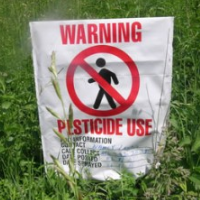Is the State Going to Replace One Awful Pesticide with an Even Worse One?

Is the State Going to Replace One Awful Pesticide with an Even Worse One?
The whole world knows that the fumigant methyl bromide is a nasty chemical with terrible consequences for the planet’s ozone layer that farmers ought not to use as a pesticide. An international agreement led to its phase-out by 2005 most everywhere except California, where strawberry farmers are rather fond of it.
An alternative in California was under consideration even before a study conducted in the Salinas Valley found that women living within three miles of farms using a methyl bromide-based pesticide on strawberries had smaller babies than normal. That study, published in Environmental Health Perspectives, a journal of peer-reviewed research and news published with support from the National Institute of Environmental Health Sciences, National Institutes of Health and U.S. Department of Health and Human Services, was the first to look at how the soil fumigant affects birth outcomes.
Methyl bromide has been linked to birth defects, prostate cancer and other health problems. And low birth rates are associated with a host of problems developed later in life. So, in response to public demand that a safer substitute be found, the state Department of Pesticide Regulation (DPR) chose methyl iodide in 2010, despite widespread opposition from scientists, environmentalists and farmworker groups.
John Froines, a professor of environmental health sciences at UCLA who chaired the peer review committee that gave input to the department before its decision, was not happy. The group recommended a maximum exposure of .8 parts per billion for farmworkers but the department set an exposure level 120 times higher. Froines said at the time, “I honestly think that this chemical will cause disease and illness. And so does everyone else on the committee.”
A lawsuit (pdf) was filed in Alameda County Superior Court in December 2010, challenging the department’s decision. Memos released in the course of the lawsuit included allegations that DPR management “mixed and matched” data that were “not interchangeable” to get the risk-assessment they wanted.
Three months after the lawsuit was filed, DPR Director Mary-Ann Warmerdam, a Governor Arnold Schwarzenegger appointee, left to take a job at Clorox. In March 2012, the manufacturer of methyl iodide products pulled them from the market in anticipation of an adverse court ruling and California went looking for a substitute.
The U.S. Environmental Protection Agency (EPA) had approved methyl iodide in 2007, but reached an agreement with the company that produced it to halt its use as of January 2013.
A new study, conducted by UCLA's Sustainable Technology and Policy Program and headed by Froines, raises significant questions about how DPR conducted itself. The report, “Risk and Decision: Evaluating Pesticide Approval in California (pdf),” didn’t find out anything about methyl iodide that wasn’t already on the record. It is a carcinogen known to cause lasting neurological damage. The chemical has been show to cause fetal damage at low doses and can induce psychiatric symptoms in adults that resemble Parkinson’s disease.
What the new study focused on was the DPR’s process for evaluating and approving pesticides, which it found to be flawed, and in the case of methyl iodide, a failure.
Froines damned the department with faint praise—he called the department’s efforts “laudable” —before noting that its evaluation of methyl iodide included “data gaps, narrow framing of the scientific issues and unrealistic assumptions regarding exposures.”
So methyl iodide is out. And methyl bromide is on the way out. Organic solutions aren’t being given any serious consideration by the powers that be, which begs the question: What’s next?
Although California Strawberry Commission Communications Director Carolyn O’Donnell says her organization isn’t prepared to back any of the fumigants currently in the pipeline, chloropicrin is getting a lot of attention.
In August, the DPR released proposed control measures, which were lauded on the Western Growers website: “Chloropicrin has been safely used for more than 50 years and it is a critical component in the growing of healthy California crops. It protects billions of dollars of crops which in turn provide thousands of farm jobs.”
Paul Towers, organizing director for Pesticide Action Network, calls it “methyl iodide 2.0.”
–Ken Broder
To Learn More:
Pesticide Regulation in California Is Flawed, UCLA Report Says (by Mark Wheeler, UCLA Newsroom)
Risk and Decision: Evaluating Pesticide Approval in California (by John Froines, Susan Kegley, Timothy Malloy and Sarah Kobylewski, Sustainable Technology and Policy Program) (pdf)
Large Scale Farming Without Toxic Pesticides is Still a Distant Dream (by Sena Christian, Earth Island Journal)
California Defied Own Scientists With Pesticide Approval (by Jen Quraishi, Mother Jones)
“Smoking Gun” Documents Show Science Ignored in Approval of Cancer-Causing Strawberry Pesticide (Earthjustice)
California Officials Manipulated Safety Data on Methyl Iodide, Ignored Scientist Warnings Against Approving Deadly Strawberry Chemical (by Ethan A. Huff, Natural News)
Warning About Strawberry Field Chemical Ignored, Scientists Say (by Amy Standen, California Watch)
Pesticide Action Network North America et al v. Department of Pestice Regulation (Alameda County Superior Court) (pdf)
Women Living Near Pesticide-Treated Fields Have Smaller Babies (by Lindsey Konkel, Environmental Health News)
Residential Proximity to Methyl Bromide Use and Birth Outcomes in an Agricultural Population in California (by Alison Gemmill, Robert B. Gunier, Asa Bradman, Brenda Eskenazi and Kim G. Harley, Environmental Health Perspectives)
The Pesticide that Won’t Go Away…Watch Your Strawberries (by Noel Brinkerhoff, AllGov)
- Top Stories
- Controversies
- Where is the Money Going?
- California and the Nation
- Appointments and Resignations
- Unusual News
- Latest News
- California Forbids U.S. Immigration Agents from Pretending to be Police
- California Lawmakers Urged to Strip “Self-Dealing” Tax Board of Its Duties
- Big Oil’s Grip on California
- Santa Cruz Police See Homeland Security Betrayal in Use of Gang Roundup as Cover for Immigration Raid
- Oil Companies Face Deadline to Stop Polluting California Groundwater





